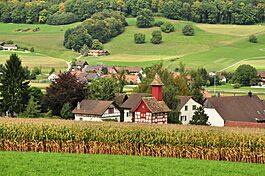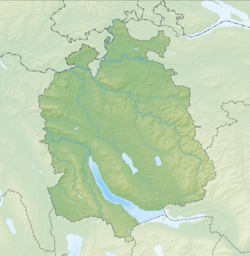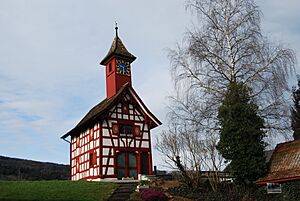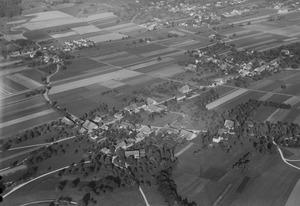Schleinikon facts for kids
Quick facts for kids
Schleinikon
|
||
|---|---|---|
 |
||
|
||
| Country | Switzerland | |
| Canton | Zurich | |
| District | Dielsdorf | |
| Area | ||
| • Total | 5.68 km2 (2.19 sq mi) | |
| Elevation | 472 m (1,549 ft) | |
| Population
(Dec 2020 )
|
||
| • Total | 858 | |
| • Density | 151.06/km2 (391.2/sq mi) | |
| Postal code |
8165
|
|
| Surrounded by | Boppelsen, Niederweningen, Oberweningen, Otelfingen, Regensberg, Siglistorf (AG) | |
Schleinikon is a small town, also called a municipality, located in Switzerland. It's found in the Dielsdorf area, which is part of the Zürich canton. It's a quiet place with a mix of natural beauty and local life.
Contents
Schleinikon's Location and Land
Schleinikon is located in a valley called the Wehntal. The town covers an area of about 5.7 square kilometers. That's roughly 2.2 square miles.
Most of the land in Schleinikon is used for farming. About half of the area is farmland. A large part, almost 43%, is covered by forests. The rest of the land has buildings and roads. A very small part is non-productive, like rivers.
Who Lives in Schleinikon?
Schleinikon has a population of around 858 people. The number of people living here has grown over the past ten years.
Most people in Schleinikon speak German. A small number of people speak English or Serbo-Croatian.
Age Groups in Schleinikon
The population of Schleinikon includes people of all ages. About 27% of the people are children and teenagers. This means they are 19 years old or younger.
Adults, aged 20 to 64, make up the largest group. They are about 63% of the population. People over 64 years old are about 10% of the population.
Education and Jobs
Many adults in Schleinikon have completed a good level of education. About 84% of people aged 25-64 have finished high school or gone on to higher education. This could be a university or a special college.
Schleinikon has a low unemployment rate. This means most people who want to work can find jobs.
The town has different types of jobs. Some people work in farming, which is called the primary economic sector. Others work in manufacturing or building things. This is known as the secondary sector. Many people also work in services, like shops or offices. This is the tertiary sector.
See also
 In Spanish: Schleinikon para niños
In Spanish: Schleinikon para niños






